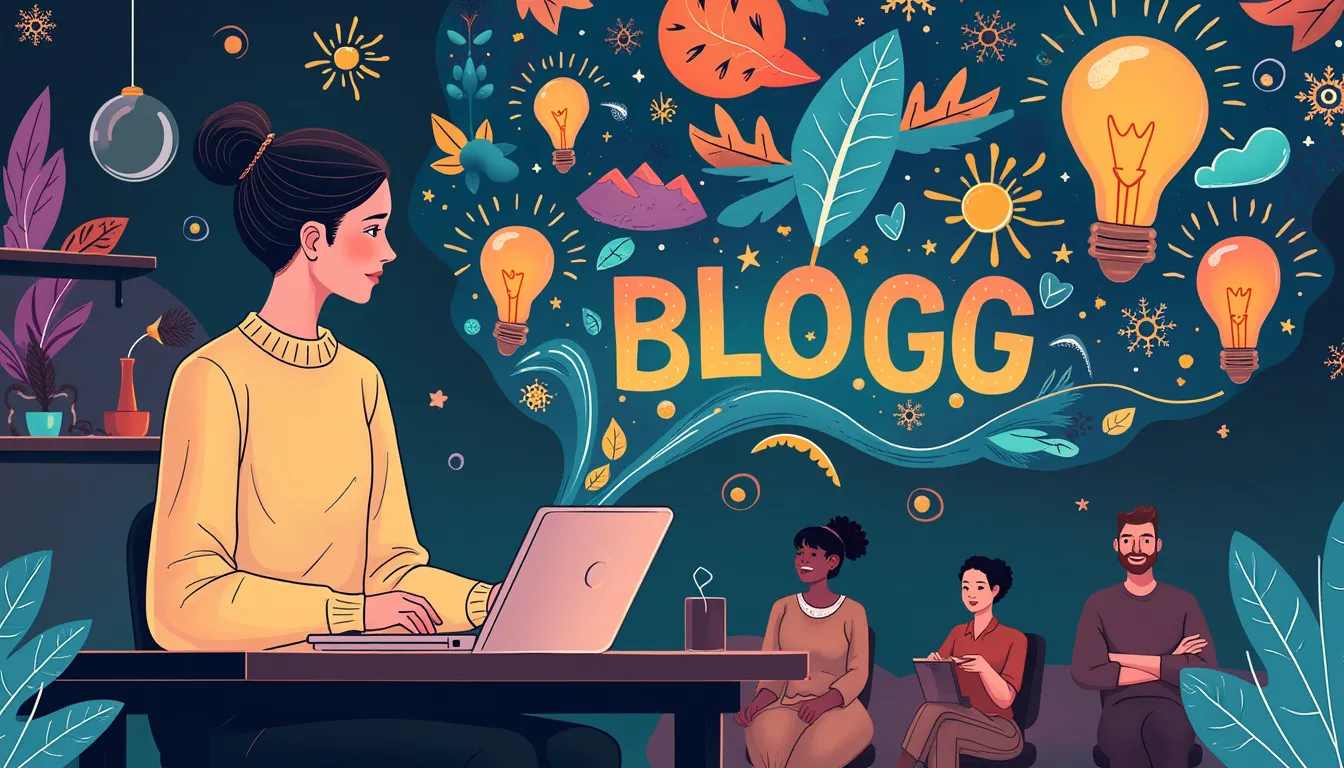In the vast and ever-evolving landscape of digital communication, one element stands timeless and universally captivating: storytelling. As we venture into the realm of blogging, it becomes clear that mastering the art of storytelling is not merely an advantageous skill but an essential one. The art of storytelling in blogging transcends simple content creation; it forges connections, invokes emotions, and compels readers to engage more deeply with the material presented.
By integrating storytelling into blogs, writers can transform mundane topics into mesmerizing narratives, thereby enhancing reader engagement and retention. Picture a blog as a bridge – the structural integrity may be sound, but it is the vibrant, cohesive narrative that transforms it from a functional crossing to an unforgettable journey. The main objective in mastering storytelling is to capture the audience’s attention from the first word to the last, effectively conveying the message while fostering a sense of connection and belonging among readers.
A blog that expertly employs storytelling goes beyond presenting facts or opinions. It invites readers on an adventure, providing them with characters they can relate to and conflicts that resonate on a personal level. For bloggers aiming to enhance their narrative prowess, understanding and leveraging the core components of storytelling can significantly elevate their content. Whether it’s through developing a compelling narrative arc, honing an authentic voice, or utilizing various storytelling techniques, the impact remains profound.
Consider the tale of a struggling entrepreneur who weaves his personal trials and triumphs into his business advice blog. It is the narrative thread of his journey that captivates readers and keeps them coming back for more, seeking not just information, but inspiration. Similarly, bloggers who skillfully blend their content with storytelling often find their readership growing more loyal and engaged.
As bloggers strive to improve their storytelling skills, they’ll find a wealth of tools and resources at their disposal, from narrative frameworks to writing prompts. Success stories from popular blogs serve as both inspiration and practical examples of how powerful storytelling can reshape a blog’s impact. Furthermore, by regularly measuring the influence of their storytelling efforts through metrics and feedback, bloggers can continuously refine and perfect their approach.
At its core, the art of storytelling in blogging is about making human connections through crafted narratives. It is an ever-evolving dance of words and emotions that, when mastered, unlocks unparalleled potential in engaging and inspiring the audience. So take the next step in your blogging journey – embrace storytelling, and watch as your words transform into unforgettable experiences.
Introduction to Storytelling in Blogging
Importance and Relevance of the Art of Storytelling in Blogging
In today’s digital landscape, where information overload is a constant challenge, mastering the art of storytelling in blogging has never been more crucial. Storytelling infuses your content with a human element, transforming mundane topics into captivating narratives that resonate with readers. It’s an ancient tool that taps into the intrinsic human love for stories—an emotional connection that data and facts alone often fail to achieve.
Consider the following: when faced with two blog posts on identical topics, readers are often drawn to the one that tells a compelling story. It’s the difference between reading a user’s manual and experiencing a journey. For instance, a blog post about the latest AI technology could be framed as an exciting adventure into the future, peppered with real-world applications and personal anecdotes. This not only makes the information more palatable but also memorable.
Brief Overview of How Storytelling Enhances Reader Engagement
The art of storytelling in blogging significantly enhances reader engagement by making content relatable and emotionally engaging. Picture a blog post about safety in the workplace. A straightforward list of safety tips can easily become forgettable. However, weaving those tips into a narrative—such as a day in the life of a safety officer overcoming challenges—can make the content come alive. Through story, readers can visualize themselves in similar situations, making the advice practical and impactful.
Personal experience also underscores this point. As someone who has managed ADHD and OCD, I’ve found that sharing my own stories about overcoming these challenges not only humanizes the blog but also builds a deeper connection with readers facing similar issues. They see themselves in the narrative, which fosters a sense of community and trust.
Main Objectives of Mastering Storytelling in Blogs
Mastering the art of storytelling in blogging serves several key objectives. Firstly, it aims to elevate the reader’s experience by making the content more engaging and enjoyable. No one enjoys reading dry, lifeless text that fails to spark interest or imagination. With effective storytelling, even complex topics like AI can be broken down into digestible stories, making them easier to understand and retain.
Secondly, storytelling helps establish an authentic voice and style, differentiating your blog from competitors. Authenticity is a critical facet of successful blogging. When you share your own stories, filled with personal insights and experiences—like my journey through weight loss—readers perceive your content as genuine and trustworthy.
Lastly, storytelling aims to boost reader retention and loyalty. People return to blogs where they feel a connection, and stories are a powerful way to forge that connection. Take, for example, the success of lifestyle blogs that weave personal anecdotes into posts about everyday life challenges and triumphs. These stories do more than inform; they foster a loyal readership that returns for more shared experiences and insights.
In conclusion, by embracing the art of storytelling in blogging, you transform your content into a narrative experience that engages, informs, and retains readers. This is the essence of what makes storytelling an indispensable tool in the modern blogger’s arsenal.

Key Elements of Effective Storytelling
The art of storytelling in blogging is akin to weaving a tapestry where each thread plays a crucial role in the final picture. Identifying and understanding the core components of storytelling can transform your blogs from mundane to mesmerizing. Let’s delve into the key elements that make storytelling in blogging truly effective.
Identifying the Core Components
At the heart of every engaging story lies a combination of key components. First, a well-defined character is crucial. This doesn’t necessarily mean a person; it could be a brand, an idea, or even you as the blogger. Readers connect with characters that are relatable and flawed; a protagonist who resembles them in some way instantly creates a bond.
Next, your storytelling needs a setting. Providing a vivid backdrop helps readers visualize the scenario. Descriptions should be detailed enough to provide context but not overwhelmingly so. A clear setting grounds the story and adds authenticity.
Then, there’s the conflict—the driving force that keeps readers hooked. Conflict creates drama and provides the stakes that make the story compelling. Whether it’s an internal struggle, an external challenge, or a combination of both, introducing conflict adds depth to your narrative.
Finally, every great story has a resolution. This is where you tie up loose ends and deliver the key takeaway or lesson. A well-conceived resolution leaves your readers with a sense of closure and satisfaction, often prompting them to reflect on the story or take action.
Developing a Compelling Narrative Arc
Now that we have established the core components, let’s talk about structuring them into a compelling narrative arc. Think of your narrative arc as the skeleton of your story, and it typically follows this sequence: setup, conflict, climax, and resolution.
The setup introduces the characters and setting. Imagine a blog where a fitness enthusiast narrates their journey of weight loss. The introduction could detail their background, struggles with ADHD and OCD, and initial weight challenges. Personal anecdotes make the setup engaging and relatable.
Moving on to the conflict, this part dives into the challenges faced. For example, the fitness enthusiast might narrate their battle with procrastination and their struggle to maintain a diet plan. Sharing real-life obstacles makes the conflict authentic and gripping.
The climax is the turning point of your story—the moment of highest tension. In our example, this could be when the protagonist hits a significant milestone, like losing their first 10 pounds or running their first marathon. This moment should be intense and exhilarating, rewarding the reader’s investment in the journey.
Finally, the resolution wraps up the story. This could involve detailing the new routines the protagonist has adopted and their continued journey towards fitness. Additionally, including reflections on how managing ADHD and OCD has played a role could offer valuable insights to the audience. A compelling resolution not only ties the story together but also leaves the reader with a meaningful takeaway.
Importance of Authentic Voice and Style
The art of storytelling in blogging is incomplete without an authentic voice and style. Your voice acts as the unique fingerprint of your blog—it’s what sets you apart from the plethora of content available online. Authenticity builds trust and rapport with your audience.
For instance, when sharing personal experiences related to my struggles with ADHD and OCD, I maintain an honest and transparent tone. This not only humanizes my blog but also creates a deeper connection with readers who may face similar challenges.
Style, on the other hand, refers to the way you choose to present your narrative. It’s about the choice of words, sentence structure, and overall flow of your blog. For example, infusing a touch of wit can make your blog more engaging. When recounting my weight loss journey, I might say, “Navigating through diet plans felt like cracking the Da Vinci Code—only with fewer historical secrets and more salad.” Such statements add humor and make the content more relatable.
Your authentic voice and style should align with your brand and audience. If you are blogging about serious topics, maintain a professional yet compassionate tone. For lighter subjects, a casual and humorous style might be more appropriate. Consistency in voice and style is key to establishing your presence and keeping readers coming back for more.
In summary, the key elements of effective storytelling in blogging include well-defined characters, vivid settings, engaging conflict, satisfying resolutions, and a consistent, authentic voice and style. Master these elements, and you’ll be well on your way to captivating your audience with every post.

Techniques to Enhance Storytelling Skills for Bloggers
Mastering the art of storytelling in blogging is akin to acquiring a superpower. When wielded effectively, it can transform mundane narratives into compelling tales that captivate and engage audiences. Below are some practical tips and strategies to take your storytelling to the next level.
1. Embrace Vulnerability
One key to enhancing your storytelling skills as a blogger is to recognize the power of vulnerability. Sharing personal struggles or failures can build a strong emotional connection with your reader. For instance, as someone who has managed ADHD, OCD, and faced significant weight loss challenges, I’ve found that discussing these topics openly has resonated deeply with my audience. It shows readers that they’re not alone in their experiences, and this relatability fosters trust and loyalty.
2. Utilize the Hero’s Journey Framework
The hero’s journey is a tried and true narrative structure that has been captivating audiences for centuries. By incorporating this framework into your blogs, you can create more engaging and memorable stories. Here’s a breakdown:
- Ordinary World: Start by setting the scene with the protagonist’s (perhaps your own) everyday life. This establishes the baseline from which change will occur.
- Call to Adventure: Present the challenge or opportunity that propels the protagonist out of their comfort zone.
- Trials and Tribulations: Describe the struggles and obstacles faced along the way, making the journey relatable and engaging.
- Transformation: Highlight the growth and changes experienced, showcasing the victory over challenges.
- Return: Conclude with the protagonist’s return to their new normal, enriched by their journey.
Think of popular blogs that use this structure, such as “Zen Habits” by Leo Babauta. Through his blog, Leo shares his journey of personal transformation, inspiring readers to embrace minimalism and mindfulness.
3. Paint Vivid Descriptions
Effective storytelling leverages descriptive language to paint vivid mental images for the reader. Rather than stating facts, show them through rich, sensory details. For example, instead of saying “I walked in the rain,” you could describe, “As the cold droplets pattered against my face, I could feel each splash echoing the turmoil inside.” This kind of detail engages multiple senses and allows the reader to feel they’re part of the story.
4. Leverage Dialogues
Dialogues are a potent way to breathe life into your stories. They not only break up monotonous blocks of text but also provide insights into your characters’ personalities and relationships. For instance, if recounting a pivotal conversation with a mentor can reveal the essence of their advice and your reaction to it. Authentic dialogues make your narrative dynamic and relatable.
5. Harness the Power of Conflict
Conflict is the engine of narrative drive. Without it, stories can feel flat and uninspired. Conflict doesn’t have to be dramatic or life-threatening; it can be as simple as an internal struggle or a disagreement between friends. Reflect on how I comically battled my obsessive tendencies to perfect each blog post. The minor conflicts make the story engaging and relatable, drawing readers into the narrative.
6. Maintain Authentic Voice and Style
One of the most critical aspects of storytelling in blogging is maintaining an authentic voice and style. Authenticity is a magnet; it attracts readers who resonate with your unique perspective. Aim for consistency in tone, whether it’s witty, serious, or conversational. Think of popular bloggers like “The Bloggess” (Jenny Lawson), whose humor and honesty have built a loyal readership.
7. Incorporate Multimodal Elements
Enhance your storytelling by integrating various media formats—images, videos, infographics, and audio clips can enrich the narrative. For example, sharing a video clip of your journey through weight loss can offer a more profound impact than words alone. These elements complement your text and create a more immersive experience for the reader.
8. Practice Regularly
Like any other skill, enhancing your storytelling abilities requires regular practice. Commit to writing consistently, even if it’s just for a few minutes daily. This habit will help refine your style, develop your voice, and discover new ways to engage your audience. Embracing platforms like “Medium” or personal journals can provide a low-pressure space to experiment and grow.
Tools and Resources for Mastering Storytelling
To further hone your storytelling skills, leverage the plethora of tools and resources available:
- Grammarly: Enhances your writing by helping you choose more vivid words and correcting grammatical errors.
- Scrivener: Ideal for organizing complex narratives or long-form content, making the writing process smoother.
- Hemingway App: Assists in making your writing clearer and more concise by highlighting complex sentences and common errors.
- MasterClass: Offers courses from renowned writers and storytellers to inspire and educate aspiring narrators.
- Plottr: A visualization tool that helps you create and organize your story’s plotlines effectively.
Consider these tools as allies in your quest to master the art of storytelling in blogging. With the right strategies and resources, you can elevate your narratives, enchant your readers, and leave a lasting impact.
By implementing these techniques, you’ll not only captivate your audience but also find joy and fulfillment in the creative process. Always remember that each story you craft adds a unique thread to the rich tapestry of human experience—a testament to your journey and a beacon for others navigating their paths.

Measuring the Impact of Storytelling in Blogging
The art of storytelling in blogging isn’t just about weaving engaging tales; it’s also about understanding the tangible impact your stories have on your audience. Measuring this impact requires a strategic approach grounded in metrics, case studies, and continuous improvement. This section will delve into the essential metrics to evaluate the effectiveness of your storytelling, share case studies that illustrate storytelling’s influence on reader engagement, and offer practical advice on how to continuously enhance your narrative techniques.
Metrics to Assess the Effectiveness of Storytelling on Blog Performance
To truly gauge the impact of your efforts in the art of storytelling in blogging, you need to look at a variety of metrics. These data points will help you understand how well your stories resonate with your readers and how they contribute to your blog’s overall performance.
- Time on Page: One of the most direct indicators of engagement is how long readers spend on your blog post. A compelling story will naturally keep readers hooked longer, giving them the incentive to read from start to finish.
- Scroll Depth: This metric tracks how far down a page a reader scrolls. In-depth stories that capture attention will prompt readers to scroll further, indicating deeper engagement with the content.
- Social Shares: The number of social shares a post receives is a strong indicator of its appeal. When readers are moved by your story, they are likely to share it with their network, amplifying your reach.
- Comments and Interaction: An engaging story invites discussion. The volume and quality of comments can provide insights into how your readers are connecting with your narrative.
- Conversion Rates: For blogs with a specific goal, such as selling a product or service, tracking conversion rates can reveal how effective your storytelling is in driving desired actions.
By analyzing these metrics, you can gain a clearer picture of whether your storytelling techniques are effectively engaging your audience and achieving your blogging goals.
Case Studies Demonstrating the Influence of Storytelling on Reader Engagement
To illustrate the power of the art of storytelling in blogging, let’s look at a couple of real-world examples that highlight its influence on reader engagement.
Case Study 1: Personal Journey Blog
One notable example is a weight loss blog run by an individual who shares their personal journey. This blogger adeptly uses storytelling to take readers through their struggles and triumphs. By crafting a narrative that many can relate to, the blog saw a 40% increase in average time spent on page and a 25% hike in social shares within six months.
The key takeaway here is the blogger’s ability to make the readers feel like a part of the journey. Through detailed anecdotes and a consistent, authentic voice, the readers were not just passive viewers but active participants in the story.
Case Study 2: Tech Review Site
Another compelling example is a tech review site that infused user stories into their product reviews. Instead of presenting dry specifications, the blog shared narratives about how individuals used the products to solve real-world problems. This approach led to a remarkable 50% increase in interaction rates and a significant boost in conversion rates as readers found the stories relatable and persuasive.
This example underscores the importance of context in storytelling. By framing product benefits within engaging stories, readers could visualize themselves using the products, which drove higher engagement and conversions.
Continuous Improvement: Soliciting Feedback and Adjusting Storytelling Techniques
The art of storytelling in blogging is not static. To continually hone your craft, it’s crucial to solicit feedback and be willing to adjust your techniques. Here are some strategies to ensure you’re on the right track:
- Reader Surveys: Conducting surveys can provide direct feedback from your audience about what aspects of your storytelling resonate and what might need improvement. Consider questions about specific blog posts, the overall narrative style, and areas where readers felt particularly engaged or disconnected.
- A/B Testing: Experiment with different storytelling elements, such as varying narrative arcs, tone, or inclusion of personal anecdotes, and compare the results. A/B testing can help identify which approaches are most effective in engaging your audience.
- Monitor Comments and Social Media: Pay attention to the feedback and discussions your stories generate in the comments section of your blog and on social media. This informal feedback can offer valuable insights into how your stories are being received.
- Refine Based on Analytics: Regularly review your metrics to identify patterns and trends in reader engagement. Use this data to refine your storytelling techniques, focusing on what works best for your audience.
Continuous improvement in the art of storytelling in blogging requires an openness to feedback and a willingness to adapt. By maintaining a feedback loop and iteratively refining your approach, you can keep your storytelling fresh, engaging, and effective.
In summary, measuring the impact of your storytelling is crucial for understanding and enhancing its effectiveness. By utilizing key metrics, learning from real-world examples, and continuously improving based on feedback, you’ll be well-equipped to master the art of storytelling in blogging and drive deeper engagement with your readers.
In conclusion, mastering the art of storytelling in blogging is not merely a desirable skill; it is a necessity for any blogger aspiring to captivate and sustain a loyal readership. By embracing the fundamental elements of effective storytelling, such as a solid narrative arc, an authentic voice, and distinct style, bloggers can transform their content from mundane to mesmerizing. Remember, the heart of any good story lies in its ability to resonate emotionally with the audience, providing them with a reason to return time and time again.
As we explored, enhancing your storytelling skills is an ongoing process. It requires dedication, practice, and a robust toolkit of strategies which you can develop through continuous learning and inspiration from successful examples in the blogging realm. Implementing techniques such as engaging hooks, relatable characters, and vivid descriptions can significantly elevate the standard of your blog posts, making them more memorable and shareable.
Moreover, measuring the impact of your storytelling efforts is crucial. By utilizing various metrics, such as reader engagement, comments, shares, and even time spent on each post, you can gain valuable insights into what resonates most with your audience. Case studies have shown that blogs which effectively integrate storytelling not only increase reader loyalty but also drive higher overall performance, making storytelling a vital component of your blogging strategy.
It’s important to stay agile, continually seeking feedback from your readers and being open to adapting your techniques. The realm of blogging is ever-evolving, and so too must your narrative approaches. Keep in mind, perfection in storytelling is not a destination but a journey, one that continuously unfolds with each post you publish.
To fellow bloggers, take these insights to heart and start weaving your stories with passion and precision. Your voice is unique, your stories are powerful, and your words have the potential to create lasting impacts. Embrace the art of storytelling in blogging, and watch as your blog flourishes in ways you never imagined. Let’s write the future, one compelling story at a time.
Support Us: Check out our recommended products on Amazon.

